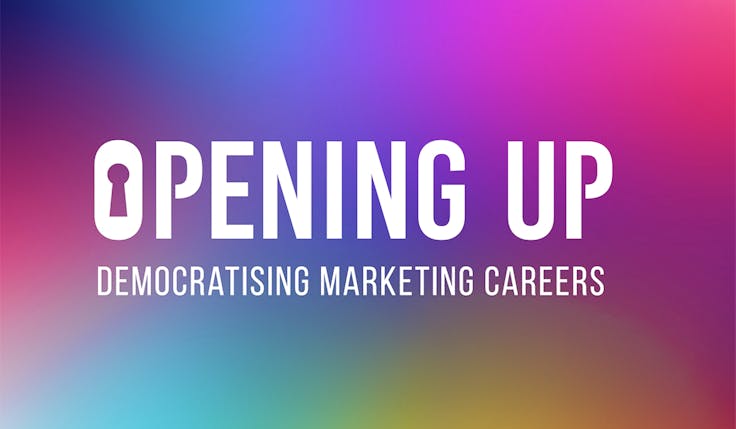‘It pays to be privileged’: Brands still failing talent from working class backgrounds
According to the Social Mobility Foundation, 17 November is Class Pay Gap Day – the point at which people from working class backgrounds effectively stop being paid.

Professionals from working class backgrounds are on average paid more than £6,000 – or 12% – less a year than more privileged peers working in the same role, according to data from the Social Mobility Foundation.
Class Pay Gap Day (17 November) marks the point at which working class professionals effectively stop being paid until the end of the year, which equates to millions of people working one in every eight days for free.
Within the private sector, which makes up 82% of the UK workforce, professionals from working class backgrounds are paid £7,774 less annually, on average, than those from professional managerial origins.
Marketing Week’s exclusive 2024 Career & Salary Survey suggests there is an even bigger problem to address within marketing. Our data finds working class marketers are being paid less than their peers, generating an average socio-economic pay gap for full-time workers of 15.9%.
Failing to reward working class staff properly isn’t just unfair; it’s bad for business.
Sarah Atkinson, Social Mobility Foundation
In 2024, it still “pays to be privileged”, argues the Social Mobility Foundation’s CEO Sarah Atkinson.
“Even when people from working-class backgrounds break into professional occupations, they’re paid some £6,000 less a year than their more privileged counterparts,” she notes.
“Failing to reward working class staff properly isn’t just unfair; it’s bad for business. Employers risk missing out on top talent with diverse perspectives, leading to weaker decision making and lower productivity.”
Last month, legal firm Browne Jacobson and professional services giant PwC UK claimed joint first place on the foundation’s annual Social Mobility Employer Index, which assesses and ranks UK employers on the actions they are taking to open up to talent from all social backgrounds. The foundation noted a 43% increase in entrants to the 2024 index from the creative industries, coupled with a 60% rise from the tech sector.
Speaking to Marketing Week on the publication of the Employer Index, Atkinson urged brands to stop seeing social mobility as a niche issue.
“Lack of socio-economic diversity is not just a problem for working class people missing out. It’s an economic problem, it’s a productivity problem,” she explained.
The barriers causing this productivity crisis can affect people from a young age. Separate polling conducted by the Social Mobility Foundation in March found half of young people (aged 16 to 24) from lower socioeconomic backgrounds have been put off applying for roles in ‘elite’ professions, such as law and finance, because of the pay gap.
A further four in ten have felt discriminated against due to their class or background.
“Socio-economic background stays with you and affects outcomes, attitudes, decisions, the way you’re seen and the way you see yourself all the way through your life,” said Atkinson.
“That’s regardless of what your socio-economic status is now. You can be in a professional job, earning money, but your background still matters and is still affecting you in terms of how your career will pan out.”
Systemic failures
Reacting to the announcement of 2024’s Class Pay Gap Day, Yasmin Hemmings, who oversees support programmes for individuals from under-represented backgrounds at social enterprise Creative Access, explains the pay gap is even more acute for ethnically diverse talent.
According to Creative Access research, almost half (48%) of ethnically diverse professionals surveyed report socio-economic bias in hiring and promotions, double that of their white counterparts (24%). A further 40% feel overlooked in their careers due to class, versus 30% of white working class professionals.
“This stark ‘class ceiling’ strongly impacts diversity in leadership. Seeing few others who share their background, working class ethnically diverse professionals face extra hurdles to advance,” says Hemmings.
“This goes beyond fairness – it’s a call for employers to adopt truly inclusive practices that address class and race, as well as disability.”
She argues the introduction of mandatory socio-economic pay gap reporting would help “dismantle” the structural barriers holding talented professionals back.
‘An economic problem’: Brands urged to treat social mobility as a business imperative
Member of the Creative Access steering group Jaber Mohamed, director of health comms and PR at MHP Group, identifies connections and money as two of the biggest barriers to entry into the creative industries.
“Lots of opportunities aren’t advertised, so you need to know the right people to get them. And the PR and comms industry is very concentrated to London, so you need to be able to afford to live here/support yourself to take advantage of those opportunities,” Mohamed notes.
“This is especially difficult if your family can’t support you/help you when you’re starting out.”
The announcement of Class Pay Gap Day comes the same week educational charity The Sutton Trust published stark findings revealing how a lack of socio-economic diversity within further education is restricting access to creative careers.
The research finds more than 50% of students studying a creative degree at Oxford, Cambridge, King’s College London and the University of Bath are from upper-middle class backgrounds. Furthermore, there are four times as many younger adults (aged 35 and below) from middle class origins than working class backgrounds working in the creative industries.
The cost of failing to embrace socio-economic diversity was laid bare in research from the Co-op and Demos, released in October. The UK economy is missing out on £19bn in GDP growth each year due to a systemic failure to promote greater social mobility in the workplace, the study found.
According to ‘The Opportunity Effect’ report, greater social mobility could generate £6.8bn in yearly tax revenues from additional economic activity, comparable to adding 540,000 new jobs to the economy or increasing private sector GDP by 1.5%.
The Co-op is calling on the government to accelerate its commitment to make socio-economic background the tenth protected characteristic under the 2010 Equality Act.
The retailer has also made a series of recommendations, from the creation of a government-backed ‘Better Opportunities Fund’ to co-invest in social mobility projects to encouraging businesses to ask job applicants to voluntarily share socioeconomic information.
Pressure mounts
Firms with more than 250 employees are already required to publish their gender pay gap and the government’s draft Equality (Race and Disability) Bill, announced earlier this year, will introduce mandatory ethnicity and disability pay gap reporting.
The Social Mobility Foundation is urging government to introduce mandatory class pay gap reporting to help unlock growth and break down barriers. Under these proposals, large employers would be required to collect and report data on the socio-economic background of their staff.
The foundation’s polling of young people aged 16 to 24 found three in four respondents believe employers should report on their class pay gap.
While 26 brands entering the 2024 Social Mobility Employer Index measure their class/socio-economic pay gaps, just 19 publish this data. Those doing so include the Co-op, legal practices Addleshaw Goddard and Browne Jacobson, as well as KPMG and PwC.
In August, the Co-op became the first retailer to publish socio-economic pay gap statistics.
‘Background to the foreground’: How the Co-op kickstarted socio-economic pay gap reporting
Calculating the pay gap between colleagues from professional and lower socio-economic backgrounds, the analysis found the Co-op has a mean socio-economic pay gap of 5.2% and a median pay gap of 0.2%.
The median compares the hourly rate of the middle professional colleague role to the middle lower socio-economic colleague role, while the mean compares the average hourly rate of pay.
The retailer has more employees from professional backgrounds working in senior leadership roles, while the biggest pay gap identified is for women from lower socio-economic backgrounds.
Indeed, the Co-op has more female colleagues from professional socio-economic backgrounds in senior roles, meaning a mean socio-economic pay gap specifically for female staff of 9.8% and a median of 1.5%.
Speaking to Marketing Week in August, Co-op head of diversity, inclusion and social mobility, Zahoor Ahmad, explained the goal behind collecting socio-economic pay gap data is to attain a “richer tapestry of understanding” on the issues impacting employees’ lives.
“You can’t just use a sheep dip approach and expect results,” he said. “There are going to be all sorts of nuances in different parts of the business, especially when you’ve got a group like the Co-op, which covers the whole nation. There are all sorts of geographical business-related nuances you need to be mindful of.”
Kickstarting socio-economic pay gap reporting opens up opportunities for powerful conversations, Atkinson told Marketing Week in October, explaining many people welcome the issue being put on the corporate agenda.
“These can be quite powerful conversations, sometimes even quite emotional conversations, but they unlock things for organisations,” she said.
“They feel like they put some power into areas you might otherwise have completely neglected, which leads you to think about some quite simple things you could do. It doesn’t always have to be huge and complex, and take years.”
 Marketing Week’s Opening Up campaign is pushing for the democratisation of marketing careers. Read all the articles from the series so far here.
Marketing Week’s Opening Up campaign is pushing for the democratisation of marketing careers. Read all the articles from the series so far here.







